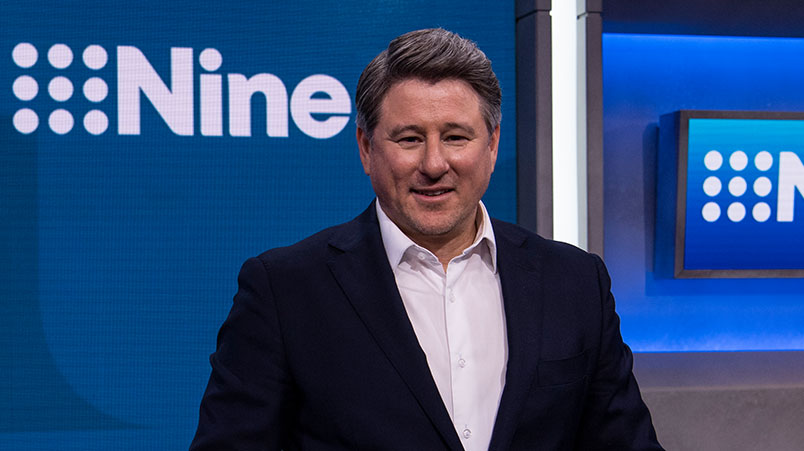Nine CEO Mike Sneesby: Live streaming outpacing on-demand viewing and platforms will ultimately overtake linear TV revenue, audiences maybe

Nine CEO Mike Sneesby: "I'm not going to put a timeframe on it. We've seen [video platform] revenue grow over several years to the point where it has hit an inflection point." Photo credit: Louise Kennerley
TV is benefiting from lockdowns once more, but amid tales of broadcasters struggling with make-goods, Nine CEO Mike Sneesby reckons audiences will stick around once they end. Posting 12 per cent year-on-year total TV revenue growth, Sneesby argued as TV’s linear audiences fall back to previous levels, viewing on its BVOD platform 9Now bridges the gap, with live streaming growing faster than on-demand viewing. He says Nine's video platforms may ultimately overtake linear TV revenues, but that future remains some way off.
What you need to know:
- Nine's Mike Sneesby believes total TV audiences will hold, even as linear viewing declines when lockdowns ease.
- The company is confident growth in live streaming linear content on its digital platforms will fill the gap.
- Sneesby said that trend enables content "efficiencies", enabling it to focus resource on live content for free-to-air and scripted drama and serialised content on Stan.
- If correct, the trend will also help keep Nine in the lead of the hotly contest signed in ID race, with the company now claiming a headline figure of 14m users as it bids to catch Australia's other walled gardens, Facebook and Google.
TV is again surging in the wake of prolonged lockdowns and while audiences are likely to plateau once they end, Nine CEO Mike Sneesby believes changing consumer habits will sustain viewership, just on its other platforms.
Speaking to Mi3 following Nine’s annual results, Sneesby, who just clocked over 100 days in the top job, said viewers are acclimatising to watching linear content as a live stream through its BVOD product 9Now.
With BVOD accounting for 10 per cent of the total digital video market, he said Nine live streaming may ultimately overtake linear audiences and revenues, but would not forecast when that might happen.
“It is a trend that will play out over the longer term and I'm not going to put a timeframe on it. We've seen revenue grow over several years to the point where it has hit an inflection point,” Sneesby said.
“At some point in the future, we'll see as the free-to-air business starts to hit a natural base in terms of audience level, that's when the continued growth in BVOD and 9Now audiences will start to close that gap.”
Same stuff, different platform
While Nine’s subscription video play Stan, which Sneesby formerly led, continues to grow audiences (reporting 2.4m subscribers) and up its investment in programmes made for the platform, 9Now will still rely on free-to-air content.
Sneesby said live streaming viewing growth was doubling the growth of on-demand viewing, suggesting the content strategy is doing its job.
“The reality is what is driving audience numbers on BVOD and on 9Now is the same content and the same programming that is sitting on FTA television,” Sneesby said.
“So it makes for greater efficiencies in our combined television business in terms of how we think about our programming strategy, which, as has always been to focus clearly on the commercial demos.
“It remains about how we deliver those outcomes on free-to-air but also turns out to be exactly what we need to deliver on the commercial side for our BVOD strategy.”
Sneesby said the differentiation for TV/BVOD and SVOD is centred around what has the greatest pull for live viewing.
He said news, current affairs, reality TV and sport continue to be the dominant properties for free-to-air and ad-funded streaming.
While Stan has generated 250,000 subscribers for Stan Sport, Sneesby said scripted drama and serialised television remains the biggest drawcard for the broader subscription market.
Bigger data
If digital growth continues, logged-in BVOD and live streaming audiences will see Nine increase its lead in the first party ID race.
Nine claims over 14 million user IDs, putting the firm ahead of its competitors, though rivals are closing the gap: Seven this month surpassed the 9m mark after a bumper Olympics haul (and Seven has question Nine's headline figure).
Nine’s Chief Sales Officer Michael Stephenson said the business aims to equal the number of users claimed by the walled gardens of Facebook and Google – both of which have somewhere between 16-17m users in Australia, though Facebook's claimed numbers have also shown to be inflated.
Nine FY21 results at a glance:
- Nine reported 76 per cent growth in net profit after tax to $277.5 million for the full year to June.
- Overall revenue lifted 8 per cent to $2.33 billion, while earnings before interest, taxes, depreciation, and amortisation was 43.5% higher at $564.7m.
- Combined TV revenue, which includes Nine Network and 9Now, increased by 12 per cent to $1.15 billion.
- In publishing, digital subscription revenues have now passed $100 million, with growth outpacing the decline in print sales.
- Publishing also reported revenue of $505m and a combined EBITDA of $117m, which was up 28 per cent on FY20
- Stan revenue increased 29 per cent to $311.8 million in the year to June and active subscribers grew to 2.4 million.
- After declining in the first half, Nine’s second half radio ad revenues grew by 13 per cent reflecting the start of the market recovery.
- Nine’s focus on agency revenues has led to some outperformance countered by a weaker result from direct sales.
- Coupled with a double-digit cost decline, Nine Radio reported EBITDA of $8m.
